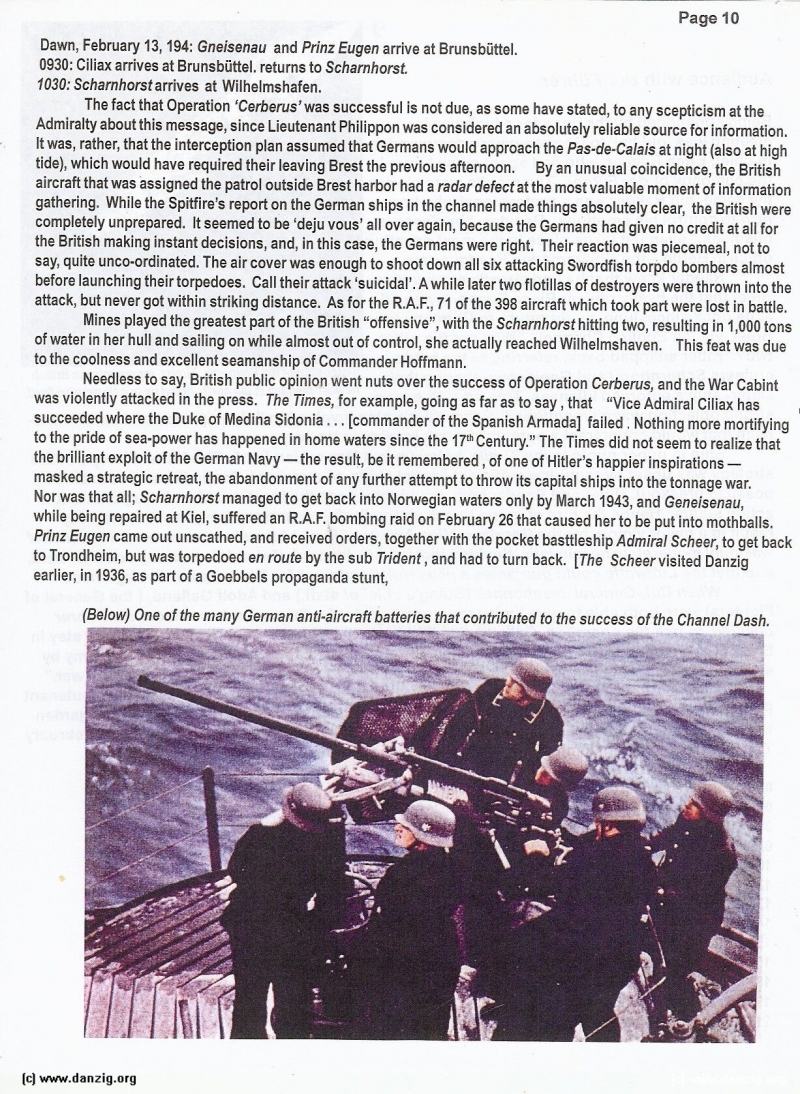
German anti-aircraft batteries
Dawn, February 13, 1941: Gneisenau and Prinz Eugen arrive at BrunsbUttel.
0930: Ciliax arrives at BrunsbUttel. returns to Scharnhorst.
1030: Scharnhorst arrives at Wil helmshafen.
The fact that Operation ‘Cetherus’ was successful is not due, as some have stated, to any scepticism at the Admiralty about this message, since Lieutenant Philippon was considered an absolutely reliable source for information. It was, rather, that the interception plan assumed that Germans would approach the Pas-de-CaIais at night (also at high tide), which would have required their leaving Brest the previous afternoon. By an unusual coincidence, the British aircraft that was assigned the patrol outside Brest harbor had a radar defect at the most valuable moment of information gathering. While the Spitfire’s report on the German ships in the channel made things absolutely clear, the British were completely unprepared. It seemed to be ‘deju vous’ all over again, because the Germans had given no credit at all for the British making instant decisions, and, in this case, the Germans were right. Their reaction was piecemeal, not to say, quite uncoordinated. The air cover was enough to shoot down all six attacking Swordfish torpedo bombers almost before launching their torpedoes. Call their attack ‘suicidal’. A while later two flotillas of destroyers were thrown into the attack, but never got within striking distance. As for the R.A.F., 71 of the 398 aircraft which took part were lost in battle.
Mines played the greatest part of the British “offensive”, with the Scharnhorst hitting two, resulting in 1,000 tons of water in her hull and sailing on while almost out of control, she actually reached Wilhelmshaven. This feat was due to the coolness and excellent seamanship of Commander Hoffmann.
Needless to say, British public opinion went nuts over the success of Operation Cerberus, and the War Cabinet was violently attacked in the press. The Times, for example, going as far as to say , that “Vice Admiral Ciliax has succeeded where the Duke of Medina Sidonia... [commander of the Spanish Armada] failed. Nothing more mortifying to the pride of sea-power has happened in home waters since the 17th Century. The Times did not seem to realize that the brilliant exploit of the German Navy — the result, be it remembered , of one of Hitler’s happier inspirations — masked a strategic retreat, the abandonment of any further attempt to throw its capital ships into the tonnage war. Nor was that all; Scharnhorst managed to get back into Norwegian waters only by March 1943, and Geneisenau, while being repaired at Kiel, suffered an R.A.F. bombing raid on February 26 that caused her to be put into mothballs. Prinz Eugen came out unscathed, and received orders, together with the pocket batttleship Admfral Scheer, to get back to Trondheim, but was torpedoed en route by the sub Trident, and had to turn back. The Scheer visited Danzig earlier, in 1936, as part of a Goebbels propaganda stunt,
(Below) One of the many German anti-aircraft batteries that contributed to the success of the Channel Dash.
Danzig Report Nr. 159 - 1st Quarter 2013, Page 10.
Hits: 3822
Added: 12/08/2015
Copyright: 2025 Danzig.org

